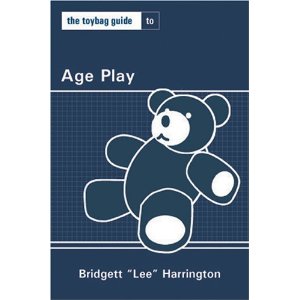Book by Lee "Bridgett" Harrington, review by BitterGrey

This easy, quick read is great for players with only an hour or two for pre-negotiation homework. It has a good scope for such a small book, achieved by focusing on general concepts instead of specific how-to details.
This book covers what an AB/DL might consider "mainstream" ageplay. Minimally, this involves partners engaging in age-related roleplay. It also raises an ideal that the ageplay relationship might develop to the point where their social intimacy permits them to fluently adapt, spontaneously following each other's lead. This fluent, spontaneous exchange depends on an established relationship, so early homework can't be skipped. Art and grace follow mechanics.
Most of book is dedicated to negotiation and preparation before the ageplay scene. Given their importance, this is appropriate. It lists four categories of things that need to be discussed; the archetypes involved, the level of investment, the presence and apparent consentuality of sex, and the presence of BDSM or bondage.
An archetype is defined as "a template, a pattern, that we will never perfectly fit." Doctor/patient is the first listed example, but stopping there would have been an oversimplification. The book proceeds through the daddy archetype, with Zeus and Yahweh as examples that only made sense after some thought. Unlike most fathers, Zeus has foaled. The complications of daddy Yahweh aren't limited to the question "Will there be a nursery in heaven?" The book doesn't dwell on these illustrations, but moves on to the dangers it was trying to illustrate. Many archetypes are only superficially universal. Ageplayers may draw on past relationships to define archetypes, but must not expect their partner to telepathically know those personal aspects. There may also be baggage, old wounds, or emotional "land mines" associated with specific archetypes, depending on the individual ageplayer. Even the ageplayer him or herself might be unaware of these.
The level of investment also needs to be discussed. How much time, money,and emotional energy will go into developing these roles? Will this be an isolated, three-minute scene, a 24/7 part of the relationship, or somewhere in between? Here and elsewhere, the book provides some interesting and useful depth that a short essay couldn't. Finally, the "type of scene" needs to be agreed upon. This is necessary since the presence of sex, coercion, force, bondage, etc. greatly affects play but doesn't necessarily follow from the roles. Some kidz don't wish to be treated like kids. (The book uses the suffix 'z' to mark ageplay role. This is ambiguous when singular.)
The book also covered a few ageplay-specific points that might not be obvious to outsiders. These ranged from the observation that the little is not necessarily the bottom, to how ageplay shouldn't be treated as just a game. For example, many littles value a sense of uniqueness. There needs to be a respect for the little's individuality. Additionally, the little's objects can have associations with past relationships that needs to be respected.
How an ageplay scene ends is important. It might be necessary to drop out of character to avoid personal land mines. Aftercare might be needed, to ensure that partners are not left in emotionally unsafe conditions. Even if the scene goes well, some followup discussion might be useful, especially if negotiation was skipped beforehand.
The author clearly acknowledges a lack of understanding of "infantilists" and "gerries![]() " - the diaper wearers. She does a decent job laying out a suitable framework, but makes a few missteps that can be easily cleared away during negotiation. One is in the ages of kidz: She equates infantilism with roleplay as a "preverbal baby" age category, as opposed to "toddler". More AB/DLs prefer the role of toddler than newborn
" - the diaper wearers. She does a decent job laying out a suitable framework, but makes a few missteps that can be easily cleared away during negotiation. One is in the ages of kidz: She equates infantilism with roleplay as a "preverbal baby" age category, as opposed to "toddler". More AB/DLs prefer the role of toddler than newborn ![]() , and may be very specific about their role age.
, and may be very specific about their role age.
In addition to role, an AB/DL and ageplayer might differ in the levels of investment. The author describes preverbal kidz as dressing in diapers or nude. This might be required by an ageplayer's wide range of roles. This wide range limits the financial investment in each role, curtailing the layette. In contrast, an AB/DL would have a specific role or narrow range of roles, permitting more focused investment. While a little might be willing to go without a diaper, most AB/DLs consider diapers an important element of the scene ![]() .
.
The author shows a sensitivity to possible overtones of incest, and of limited permanence. She suggests calling the ageplay parent a different name than the one used for the biological parent, such as "papa" instead of "dad." This would be one way to differentiate ageplay from the kidz actual childhood. She also stressed selecting roles based on the investment and relationship: Intimate and unique roles such as mommy or daddy should be played only when long-term, regular contact is expected. This avoids the risk of kidz forming strong bonds to someone who agreed to be a mommy or daddy, but only to do so once. Less lasting scenes should use less permanent archetypes.
Overall, this book is a useful read for AB/DLs. However, it might lead others to overestimate the similarities between ageplayers and AB/DLs.
Do you have Questions, tips, suggestions, or other feedback?